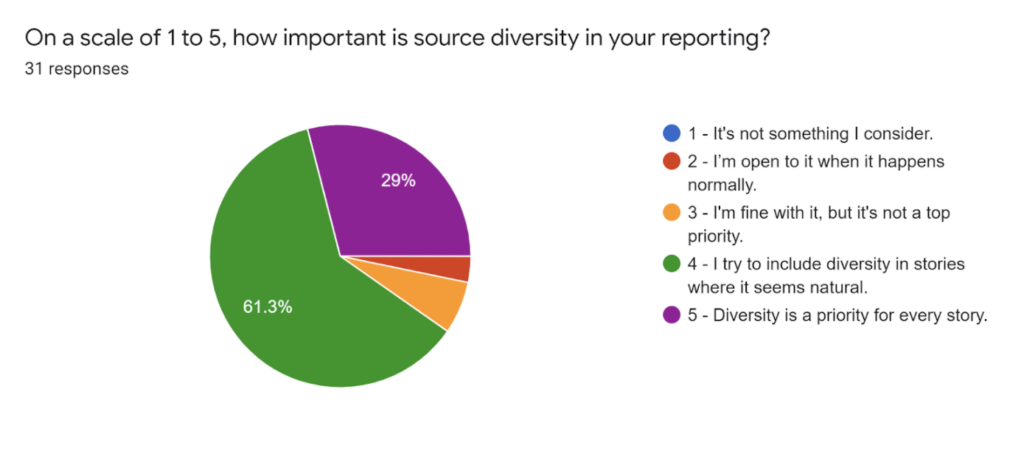
Make your reporting more diverse: Try a different network, redefine experts
In the survey of 750 journalists, editors and producers conducted by ExpertFile in conjunction with The Associated Press, journalists acknowledged that there remains a significant gap in representing a more diverse set of experts in their coverage. Despite a recognition of the need for more diverse voices in their coverage, the national survey also found that two-thirds of journalists rely heavily on their own personal contacts. This means that if the newsroom staff is not diverse, the sources likely won’t be either.
Over the past month, my newsroom partners at NC Health News, WFAE and the Charlotte Observer distributed a 10-question survey of our own to the journalists participating in the diversity in sourcing project. The objective was to determine, among other things, their views on diversity in reporting, how this currently impacts their reporting and, based on where they are now, what kind of training will help them improve the diversity of their reporting.
The responses that continue to trickle in affirm the need and interest for this training, and also provide valuable insight about the best way to structure it.
Attitudes regarding diversity
Virtually all respondents said they not only wanted to include more diversity in their reporting but believed that doing so made their reporting and storytelling better and richer.
When given a list that included race/ethnicity, gender, socioeconomic, LBGTQ, geography, religion, age and socioeconomic status, the overwhelming majority of respondents selected race and/or ethnicity as the first determinant in diversity. Gender ranked a distant second and LBGTQ came in a close third.
Asked about their efforts to include more diversity in their reporting, 91 percent of respondents said they either try to include diversity in every story where it seems natural or make it a priority for all of their reporting.

The challenges
For a variety of reasons, finding “real people” who are willing to talk often poses a challenge, particularly when it comes to controversial or personal topics. That’s why many beat reporters repeatedly use the same sources over and over.
Nearly one-third of all respondents said that the biggest obstacles to including more diverse sources was that they lacked a network of diverse sources and 15 percent say the crush of deadlines makes finding new people to interview more difficult.
The AP/Expert News survey noted that sourcing experts remains a time-consuming process; it takes a journalist two hours on average to secure an expert for an interview. The need for diversity only exacerbates the problem. “I have a beat where 95% of the decisions I cover are made by white men,” said one respondent. “In many cases, the people who are in power are not diverse,” said another.

So then how do journalists identify experts and go about finding experts to interview? Most respondents cited resume, credentials and formal training in a particular area. Only one person mentioned “lived experience” and another said people who are impacted by the issues. Maybe then, journalists need to broaden the definition of whom we consider as experts.
A real difference can be made in determining how we find these experts. Most journalists reported relying on PR agencies, universities, and online and social media searches. The Internet and social media make it easier to reach beyond the usual suspects but only if we broaden the search to include things like researchers at HBCUs and people who may have been quoted in media targeted to underrepresented populations.

What should our training look like?
Some of the journalists surveyed have previously attended workshops on equity and inclusion, as well as implicit bias training sponsored by their employers or community groups. While they felt that this helped them recognize their own biases, most felt the training only scratched the surface and revealed how much work there is to do. Therefore, they say, the training must go deeper and be more specific to journalism.
“The effort to diversify sources in our stories . . . is the low-hanging fruit,” said one respondent.
“We have much less structure around how we choose news stories to pursue. I would like to see us intentionally chasing news angles and subjects that organically lead to better diversity in our coverage.” This is an idea I had not considered but will address in the curriculum because it seems quite relevant. Story selection alone goes a long way to addressing the diversity issue.
Next steps
While the respondents are willing and eager to participate in this training, many don’t know where to begin. The first of four monthly pop-up newsletters will go out in September. The first issue will address ways journalists can create their own readily available source list and include a curated list of groups and associations for people of color that can be used to find sources.
Please go here to sign up for the newsletter.
